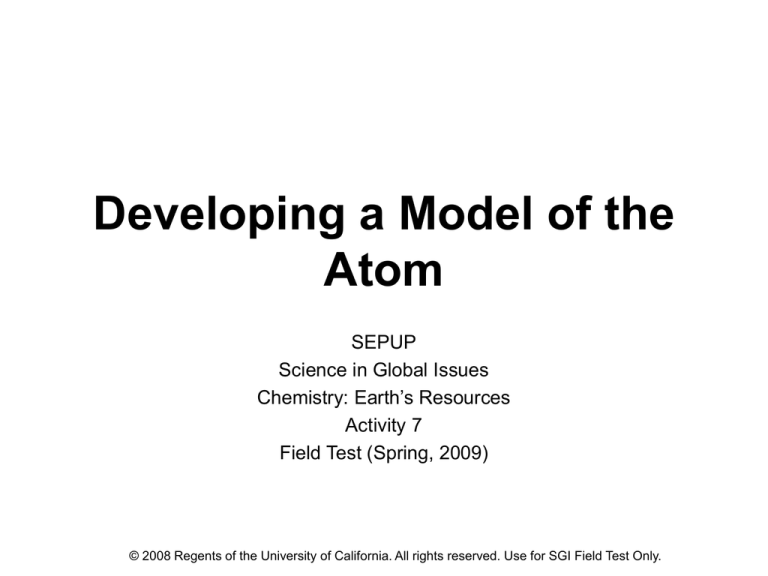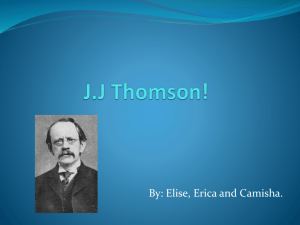
Developing a Model of the
Atom
SEPUP
Science in Global Issues
Chemistry: Earth’s Resources
Activity 7
Field Test (Spring, 2009)
© 2008 Regents of the University of California. All rights reserved. Use for SGI Field Test Only.
Elements and Compounds
Examples of elements include:
copper (Cu), aluminum (Al), iron (Fe), oxygen
(O2), hydrogen (H2)
Examples of compounds include:
water (H2O), table salt (NaCl), carbon dioxide
(CO2), aluminum oxide (Al2O3), sulfuric acid
(H2SO4)
How are compounds different from elements?
Discuss with your group and record your answer in
your science notebook
© 2008 Regents of the University of California. All rights reserved. Use for SGI Field Test Only.
John Dalton
(Early 1800’s)
Proposed an atomic theory that included the following:
• Each element is composed of extremely small
particles called atoms.
• All atoms of a given element are identical.
• Atoms of one element are different from atoms of
another element.
• Atoms of an element are not changed into different
types of atoms by chemical reactions.
• Compounds are formed when atoms of more than
one kind combine.
• In a given compound, the relative number and kind of
atoms are constant.
© 2008 Regents of the University of California. All rights reserved. Use for SGI Field Test Only.
Developing an Atomic Theory
• Many scientists have modified and
elaborated on Dalton’s Atomic Theory.
• The first major advances were possible
with the development of gas discharge
tubes.
• Sir William Crookes was a leader in
experiments with gas discharge tubes.
© 2008 Regents of the University of California. All rights reserved. Use for SGI Field Test Only.
Sir William Crookes
(mid to late 1800’s)
Crooke's tube demo.
© 2008 Regents of the University of California. All rights reserved. Use for SGI Field Test Only.
Sir William Crookes
(mid to late 1800’s)
Evidence:
• When a high voltage supply was attached to the ends
of the tube, there was a glow at the positive end of the
tube.
• When the negative terminal was moved the glow
moved with it, but not when the positive terminal was
moved.
• If a piece of metal was placed between the negative
and positive terminals, a shadow was produced in the
glow. The shadow had an identical shape to the metal.
What inferences could be made from these observations?
Discuss with your group and record your answer in your
science notebook
© 2008 Regents of the University of California. All rights reserved. Use for SGI Field Test Only.
Cathode Rays
Claim:
• Something was produced at the negative
terminal (cathode) and traveled towards the
positive terminal (anode).
• Whatever was being produced at the cathode
traveled in straight lines towards the anode
and was not able to pass through the metal.
© 2008 Regents of the University of California. All rights reserved. Use for SGI Field Test Only.
Cathode Rays
Reasoning:
• The cathode was the source of the rays because the
rays moved every time the cathode was moved.
• The rays must travel in straight lines because the
shape of the shadow was identical to the shape of
the object that produced it.
Because it was coming from the cathode and it
traveled in straight lines, this phenomenon was called
a cathode ray.
© 2008 Regents of the University of California. All rights reserved. Use for SGI Field Test Only.
Sir J.J. Thomson
(Late 1800’s)
http://www.aip.org/history/mod/fission/fission1/01.html
http://dbhs.wvusd.k12.ca.us/webdocs/AtomicStructure/Disc-of-Electron-Images.html
© 2008 Regents of the University of California. All rights reserved. Use for SGI Field Test Only.
Sir J.J. Thomson
(Late 1800’s)
Evidence:
• When cathode rays traveled through an electric field they
were repelled from the negative side of the field and
attracted to the positive side.
• From measuring the deflection of the cathode rays in
combinations of electric and magnetic fields, Thomson was
able to determine that cathode rays had charge and mass.
• The same results were obtained no matter what the
cathode was made from.
What inferences could be made from these observations?
Discuss with your group and record your answer in your
science notebook
© 2008 Regents of the University of California. All rights reserved. Use for SGI Field Test Only.
Electrons
Claim:
• Cathode rays were composed of a stream
of negatively charged particles.
• These particles were fundamental to all
atoms.
© 2008 Regents of the University of California. All rights reserved. Use for SGI Field Test Only.
Electrons
Reasoning:
• The particles were negative because they
were repelled by negative charges and
attracted towards positive charges.
• The particles were fundamental to all atoms
because the same results were found no
matter what material was used to produce the
electrons.
© 2008 Regents of the University of California. All rights reserved. Use for SGI Field Test Only.
Electrons
These particles were given the name electrons.
Later Robert Millikan, in the USA, determined the
charge on an electron.
His results, when combined with Thomson’s, allowed
scientists to calculate the mass of an electron.
© 2008 Regents of the University of California. All rights reserved. Use for SGI Field Test Only.
Thomson’s Model of the Atom
Evidence:
• Thomson had determined that atoms
contained negative particles called
electrons.
• However, atoms were electrically neutral.
What inferences could be made from this information?
Discuss with your group and record your answer
in your science notebook
© 2008 Regents of the University of California. All rights reserved. Use for SGI Field Test Only.
Thomson’s “Plum Pudding” Model
Claim:
(Early 20th century)
Atoms contain an equal amount of positive
charge as negative charge
Thomson suggested
that the electrons in
an atom were
embedded in a
positively charged,
diffuse sphere.
© 2008 Regents of the University of California. All rights reserved. Use for SGI Field Test Only.
Thomson’s “Plum Pudding” Model
(Early 20th century)
Reasoning:
• Since atoms were electrically neutral but
contained negatively charged electrons, they
must also contain an equal amount of positive
charge.
• Thomson had no experimental evidence for
his model but built on Lord Kelvin’s idea that
positive charge in an atom was spread evenly
and diffusely throughout a spherical shape.
© 2008 Regents of the University of California. All rights reserved. Use for SGI Field Test Only.
Rutherford, Geiger, and Marsden
(Early 20th Century)
Positively charged alpha-particles were directed at a
piece of thin gold foil.
© 2008 Regents of the University of California. All rights reserved. Use for SGI Field Test Only.
Rutherford, Geiger, and Marsden
(Early 20th Century)
Evidence:
• Most of the alpha particles passed through the gold
foil, but some were deflected at varying angles.
• Note: If the “plum pudding” model was correct and
the positive charge was diffuse, then the high energy
alpha particles should be able to pass through the
positive matter of the atoms of gold foil with limited
deflection.
What inferences could be made from this information?
Discuss with your group and record your answer in your
science notebook
© 2008 Regents of the University of California. All rights reserved. Use for SGI Field Test Only.
The Nuclear Model of the Atom
Claim:
• The positive charges in an atom are not diffuse and
instead must be concentrated into a small space.
•Most of an atom is empty space.
Rutherford Scattering
© 2008 Regents of the University of California. All rights reserved. Use for SGI Field Test Only.
The Nuclear Model of the Atom
Reasoning:
• Most of the alpha particles were able to pass through the atoms
with little or no deflection, therefore the atom was mainly empty
space.
• There must be a concentration of positive charge in order to
cause the alpha particles to be deflected by large angles.
• This concentration of positive charge must be very small or
more alpha particles would have been deflected by large angles.
The region of concentration of positive charge in an atom was
called the nucleus.
The positively charged particles in the nucleus were called
protons.
© 2008 Regents of the University of California. All rights reserved. Use for SGI Field Test Only.
Expanding the Nuclear Model of
the Atom
Evidence:
• Atoms are electrically neutral.
• The mass of an atom is greater than the
sum of the mass of its protons and
electrons.
What inferences could be made from this information?
Discuss with your group and record your answer in your
science notebook
© 2008 Regents of the University of California. All rights reserved. Use for SGI Field Test Only.
Sir James Chadwick
(1932)
Claim:
• There must be other particles in the
atom.
• These particles must have mass but no
charge.
© 2008 Regents of the University of California. All rights reserved. Use for SGI Field Test Only.
Sir James Chadwick
(1932)
Reasoning:
• The mass of an atom is greater than the
mass of its protons and electrons.Therefore
there must be another particle in the atom
that has mass.
• This additional particle must not have any
charge, because if it had charge then the
atom would no longer be electrically neutral.
In 1932, James Chadwick confirmed the existence of
these particles, called neutrons.
© 2008 Regents of the University of California. All rights reserved. Use for SGI Field Test Only.
Summary of the Nuclear Model of
the Atom
• Atoms contain protons, neutrons, and electrons.
• Protons are positive, electrons are negative, neutrons
have no charge.
• Protons and neutrons contain most of the mass of an
atom.
• Protons and neutrons are located in the nucleus,
which is very small.
• Electrons are located outside the nucleus.
© 2008 Regents of the University of California. All rights reserved. Use for SGI Field Test Only.






